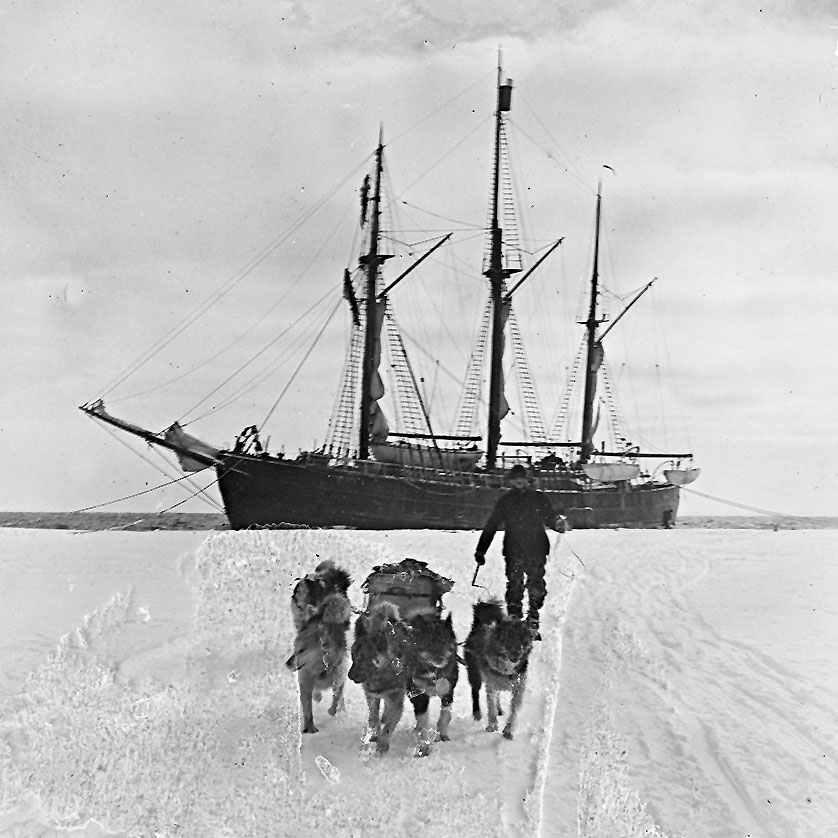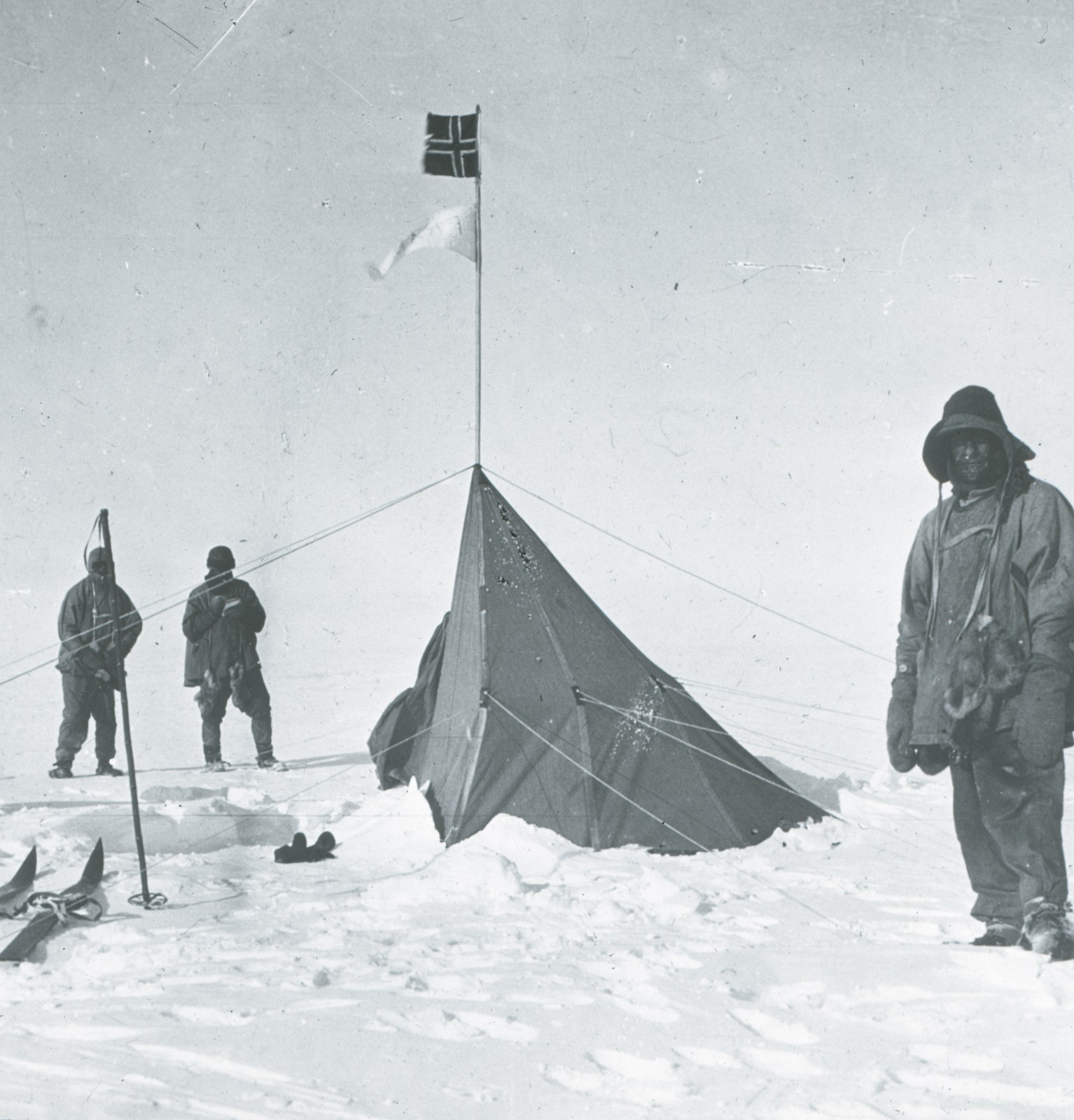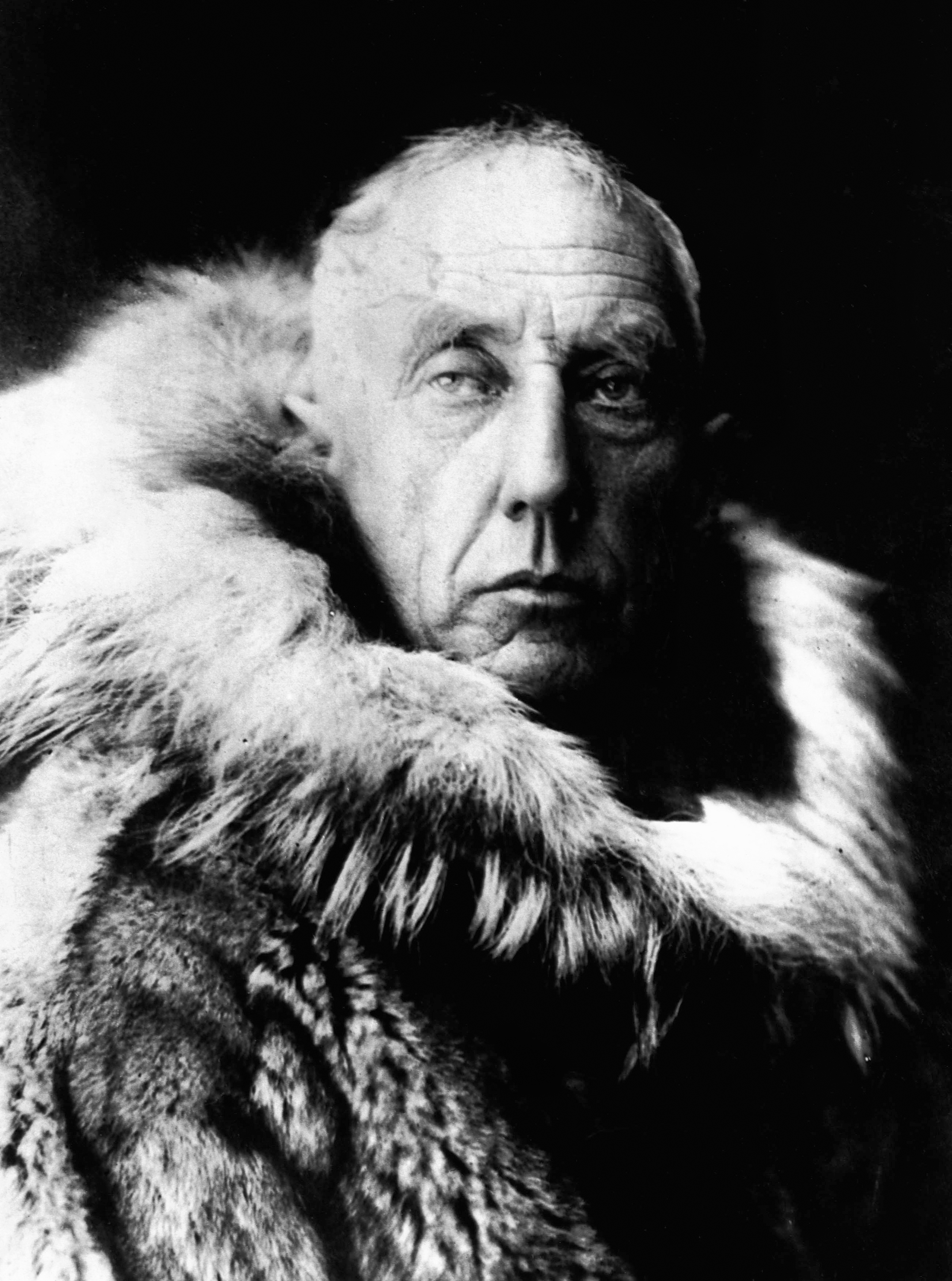Friday, March 29, 1912, Captain Robert F. Scott writes in his
his diary his last words: "For God's sake, take care of the
our". It is found in a tent in Antarctica at 700
km. from the South Pole. He is accompanied by Lieutenant Bowers and Doctor Wilson,
all of them in an extreme situation, and aware of the
inevitability of the outcome. Outside, with temperatures around
-40 ºC, a terrible blizzard that seems to have no end holds them back
immobilized.
Inside, the situation is not much better.
are completely exhausted after almost 5 months of
expedition. Under normal conditions they would be less than two
days of marching to reach what they had called "Deposit of
the Great Tonne", located less than 20 km away. Reaching this deposit,
located at 79º 29' S, it is essential to be able to return to the
base located on Ross Island. Even so, they would still have more than
200 km. for the purpose of the expedition, but unable to reach
this provisioning, death approaches them inexorably, and they are
aware of it.
The warehouse is located in the middle of the vast plain with boxes stacked up to a height of 2 meters. By his decision it was established farther than initially anticipated. A year ago he made a decision that would be key to the outcome of the expedition. Affected by the suffering the horses were enduring - one of them found completely bloody- he ordered to establish the provisioning 56 km earlier than planned, at 80º latitude, for he could not violate his convictions by advancing a few kilometers more.
They have been trying to advance for days, but the blizzard hits them hard. force, and makes it impossible for them to advance. In addition, the low temperatures they cause the march to be desperately slow. below the 40º ice floor is as rough as rough concrete, the friction of the sled with the frozen surface is enormous and for to beat him takes an effort that the three brave Englishmen they can barely perform. All this despite having lightened the load, since they have abandoned the theodolite, the photographic camera and everything expendable. Everything except journals and geological samples collected in the descent of the Beardmore Glacier, the only thing really very heavy that they refuse to give up, and that later would be very valuable for validating plate tectonics. suffer serious frostbite in the extremities. They only have food for two days, and fuel for one, they also need to get water, since melting snow and ice directly in your mouth requires a few calories that they already lack, and that, paradoxically, increases the dehydration.

Scott keeps wondering what has gone wrong. As head of the expedition has had to make hard decisions. He was aware that the fate of 5 men was going to depend on the success of the planning and now, inevitably, they are all going to die in the attempt to conquest of the South Pole. What has gone wrong? planning?, the diet -are they totally malnourished-?, The horses? The equipment? These and many other questions are not they stop harassing Scott.
After so many efforts to reach the destination - on January 17 they had reached the south pole - they receive a hard blow when they see the flag Norway waving, and check that the other expedition has advanced; but undoubtedly even harder is the return, with the death of two of his companions. First, Lieutenant Evans, gigantic and womanizer, lover of beer, which occurs during the descent of the glacier; and then Captain Oates who, on the day of his His 32nd birthday, he leaves the store never to return. both behaved in an exceptional way, enduring pain without complaining, without allow oneself to be overcome by adversity, in an attitude of value extraordinary. However, the physical problems of both slowed down the expedition, also marking its destination, and now it is they are unable to reach the supply point.
After several attempts to resume the march, they fail due to the adverse weather conditions. Scott tries to cheer up, but his strength leaves him, in those moments he misses being able to continue writing in his diary, with so many things to tell. But write, something that may seem so simple to us, in its conditions supposes quite a daunting task. Malnutrition and dehydration will prevent. Despite his failure, he already only hopes that the whole world recognize the worth of these men.
It is now 100 years since one of the greatest milestones of the exploration of the planet, the conquest of the South Pole, which also, of extraordinary human interest, with a career between Norwegian Roald Amundsen, final winner, and British Scott who, In addition to being defeated in this contest, he would pay with his life for the try. It is worth stopping to know some details of these fascinating expeditions to the last still unexplored corner of the planet.
Among the background of this expedition, we can find that Amundsen participated as helmsman in the Belgian Antarctic expedition of 1897, where Cook also participated, and later directed the first expedition that managed to cross the mythical northwest pass between the Pacific and Atlantic oceans; so he was already an accomplished and renowned explorer. The same thing happened with the other contender, Scott, who made a first reconnaissance expedition in 1900 with the ship Discovery, and where they reached 82°17' S of latitude setting the record of the time.
On the other hand, another member of Discovery, Ernest Shackleton, made an attempt in 1907 aboard the Expedition. For which they established his base on Ross Island, and made their attempt using ponies of Manchuria instead of dogs, which had not given the results previously expected. However, on this occasion he improved a lot with the change, having to rely fundamentally on the shot of the men themselves for transport. The expedition was at about to succeed, reaching 88°23' and only remaining 180 km. del Polo, making the decision to back down before the high risk of their own lives.
In 1910, aboard the Terra Nova, Scott made a new attempt, correcting some of the defects observed by the own Shackleton. So he could achieve success, which he finally achieves, although with the consequences that we already know. He uses dogs as shots, horses and fundamentally the human effort itself; and furthermore, in a meritorious commitment to technology, he also carries three sleds motorized with tracks, although all prototypes are still experimental, the best of which sank during unloading. However, your fundamental bet of him, as Shackelton did, were the horses and his own men his; which was one of his first mistakes.

The same year the Amundsen expedition takes place. although this explorer initially poses his expedition as directed to the Pole North, getting the Norwegian government to give him the ship Fram, a sailboat perfectly adapted to polar navigation, assisted by a coal engine than Amundsen himself, also in a bid for the emerging technology, replaced by another diesel. After his departure from Norway, on the stopover in Madeira, announces to the world, completely by surprise, the change of his plans, and his new route to the South Pole, and avoiding making new stopovers, in order to prevent the possible reception of return orders from the Norwegian government, which could fear of antagonizing the powerful United Kingdom. This change was due to the fact that the North Pole had already been conquered, settling also in those moments the dispute between Peary and Cook for its authorship, for which he anticipated little recognition if he accomplished that feat. as traction for the sledges, Amundsen made a wiser decision than his opponent of him He relied solely on huskies, perfectly trained and knowledgeable keepers of him, who now functioned at The perfection.
In their approach to the attack, both followed similar lines; establishing base camps, and supply depots for the return. Scott established it on Ross Island and followed the same Shackelton's route for the ascent to the plateau. The last and main of his deposits he called it the "Great Tonne", although, and as already we have commented had to be established 56 km. ahead of schedule.
For his part, Amundsen established his base in the Bay of Whales, that he was situated somewhat closer to the target than the British base, if he well he had the drawback that the route to follow was completely unknown. During the previous summer he managed to establish three deposits, at heights of 80º, 81º and 82º, which facilitated the later way back. Furthermore, Amundsen made no qualms about feed the dogs, and even themselves, with the dogs deceased or directly slaughtered when they were no longer needed, what the British did not do because of Scott's own opposition.
With the southern summer both expeditions leave for their destination. The Norwegians on October 19, and the British on November 1. Already from their first steps Amundsen's dogs function to the perfection, although half of them are sacrificed upon reaching perfection. top of the plateau, being no longer necessary. On the contrary, Scott's combination of dogs, horses, and motorized vehicles doesn't give the expected results.
On December 14, the Norwegians reach their goal, the South Pole, while the British in those moments have only reached the plateau superior, with little more than half of the way done. Those they begin to return, with time getting worse for the misfortune of the British. Scott manages to reach the Pole on January 17, while Amundsen, with an already exhausted team, manages to reach the first deposit of provisions and regain strength. At the finish, the British find the Norwegian flag and a letter from Amundsen addressed to they. The famous photo they took reflects the despondency they must have feel.
The road back for Scott's team was extremely hard, much more than for the Norwegians, due to the extreme conditions climatic. And while on January 25, they arrive at their destination final, the Bay of Whales, by then Scott and his team were still They have not reached 88º. On February 7th they reach the limit of the plateau completely exhausted, and in unbelievably atrocious weather they must invest more than a month in their descent, and in that interval they produces the death of the first fallen, Evans. March 17 occurs the death of Oates who, unable to continue, decides to leave camp at night without warning, in order to avoid being a burden to his companions, who refused to abandon him. But that generous sacrifice is useless because finally, on March 20, they see definitively stopped by a great storm, having already exhausted broadly all his might. They were 18 km away. from the deposit of the Great Ton, which they would have already reached if they had been located in the intended location, and perhaps saved their lives and even Oates's.
Although Amundsen's expedition was better prepared, Scott's, even with his flaws, he still might have succeeded had he not counted on extraordinarily adverse weather, one of the worst winters of those recorded in the entire 20th century, and even the bad luck of the moment chosen to establish the deposit for the return, where also due to bad weather they had to adopt their hard decision.
Scott's diary, found next to his body, reflects his extraordinary personality of him, and contributed to his expedition having, if possible, greater recognition than that of the winner himself. And still today 100 years after that feat, it is not possible remain indifferent when reading his last note: "We will resist until the end, but death cannot be far away. Is a It's a pity, but I think I won't be able to continue writing anymore. For the love of God, take care of us". As Stefan Zweig already said of this tragic story: "It is the greatest tragedy of all time, the one that, from time to time, manages to create a poet, and life thousands times".
Scott's diary, found next to his body, reflects his extraordinary personality of him, and contributed to his expedition having, if possible, greater recognition than that of the winner himself.
The publication of the newspaper somewhat obscured the triumph of Amundsen. He even contributed to underestimating his own difficulties in his, presenting them as less than what in reality were. On his victory, achieved after traveling 1,280 km. In 55 days he wrote in his diary: "The objective was reached, the journey... I can't say that I have reached my life's goal. The The North Pole had attracted me since childhood, and there it was, at the Pole South. Is it possible to imagine something more absurd?"
Today, at the South Pole there is an international scientific base belonging to all signatory countries of the Antarctic Treaty and named after Amundsen-Scott base; what is a well-deserved explicit recognition for both explorers. What curiosity, indicate that it is quite displaced from the place reached 100 years ago by the expedition members. Close to the base is the so-called Ceremonial South Pole, where a metallic sphere is located on a pedestal, surrounded by the flags of the countries, and which is located a few meters from the real Geographic South Pole, since it does not is in a fixed place - it is marked only by a stake - because because the whole area is located on a moving glacier that is moves at about 10 meters per year, so every New Year's Day, the stake must be repositioned to the correct place.

